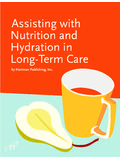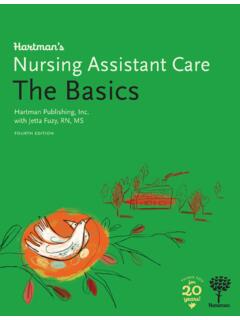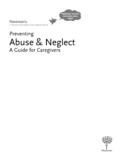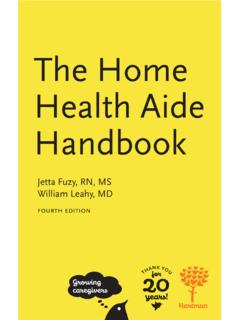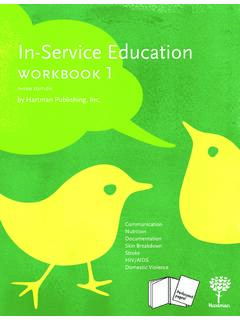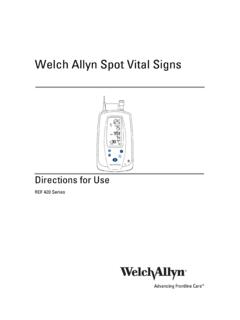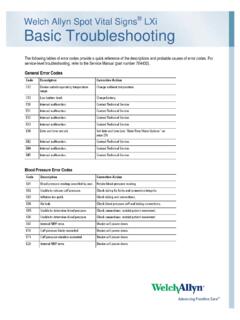Transcription of Hartman’s Nursing Assistant Care
1 Hartman s Nursing Assistant CareThe BasicsHartman Publishing, Inc. with Jetta Fuzy, RN, MSfourth editionSpecial ThanksA heartfelt thank you goes to our insightful and wonderful reviewers, listed in alphabetical order:Theresa J. DeBon, RN, BS Tulsa, OKRuth Hardke, RN Stow, OHCharles Illian, RN, BSN, Infection Preventionist Orlando, FLMarie Johnston, RN Harrisburg, PASally Lyle, RN, BSN Rock Hill, SCWendy Pickard-Tanios, RN, BS, ONC Round Rock, TXChristine A. Smith, RN, MSN Poquoson, VAWe are very appreciative of the many sources who shared their informative photos with us: Briggs Corporation Detecto Dreamstime Exergen Corporation Harrisburg Area Community College Dr. James Heilman Hollister Incorporated Invacare Corporation Medline Industries National Pressure Ulcer Advisory Panel North Coast Medical, Inc. Nova Medical Products RG Medical Diagnostics of Wixom, MI Starkey Hearing Technologies Vancare, Inc. welch AllynGender UsageThis textbook utilizes the pronouns he, his, she, and her interchangeably to denote healthcare team members and Editor Susan Alvare HedmanDesigner Kirsten BrowneCover Illustrator Jo TroncProduction Thad CastilloPhotography Matt Pence, Pat Berrett, Art Clifton, and Dick RuddyProofreaders Kristin Calderon, Kristin Cartwright, Melanie Futrell, and Eliza MartinSales/Marketing Deborah Rinker, Kendra Robertson, Erika Walker, and Belinda MidyetteCustomer Service Fran Desmond, Thomas Noble, Angela Storey, Eliza Martin, and Chris WhitlockWarehouse Coordinator Chris MidyetteCopyright Information 2014 by Hartman Publishing, Inc.
2 1313 Iron Ave SW Albuquerque, NM 87102 (505) 291-1274 web: email: Twitter: @HartmanPubAll rights reserved. No part of this book may be reproduced, in any form or by any means, without permission in writing from the 978-1-60425-050-3 PRINTED IN THE USAN otice to ReadersThough the guidelines and procedures contained in this text are based on consultations with healthcare profession-als, they should not be considered absolute recommenda-tions. The instructor and readers should follow employer, local, state, and federal guidelines concerning healthcare practices. These guidelines change, and it is the reader s re-sponsibility to be aware of these changes and of the policies and procedures of his or her healthcare facility. The publisher, authors, editors, and reviewers cannot ac-cept any responsibility for errors or omissions or for any consequences from application of the information in this book and make no warranty, express or implied, with re-spect to the contents of the book.
3 The publisher does not warrant or guarantee any of the products described herein or perform any analysis in connection with any of the prod-uct information contained herein. ease m l and sugges o s to t r@ ar manon The Nursing Assistant in Long-Term Care1. Compare long-term care to other healthcare settings 12. Describe a typical long-term care facility 23. Explain Medicare and Medicaid 34. Describe the Nursing Assistant s role 35. Describe the care team and the chain of command 56. Define policies, procedures, and professionalism 77. List examples of legal and ethical behavior and explain Residents Rights 108. Explain legal aspects of the resident s medical r e co rd 179. Explain the Minimum Data Set (MDS) 1910.
4 Discuss incident reports 192 Foundations of Resident Care1. Understand the importance of verbal and written communications 202. Describe barriers to communication 233. List guidelines for communicating with residents with special needs 254. Identify ways to promote safety and handle non-medical emergencies 305. Demonstrate how to recognize and respond to medical emergencies 356. Describe and demonstrate infection prevention practices 443 Understanding Residents1. Identify basic human needs 582. Define holistic care 603. Explain why promoting independence and self-care is important 604. Identify ways to accommodate cultural differences 615. Describe the need for activity 626. Discuss family roles and their significance in health care 637. Describe the stages of human development 648.
5 Discuss developmental disabilities 679. Describe some types of mental illness 6710. Explain how to care for dying residents 6911. Define the goals of a hospice program 744 Body Systems and Related Conditions1. Describe the integumentary system 762. Describe the musculoskeletal system and related conditions 773. Describe the nervous system and related conditions 814. Describe the circulatory system and related conditions 875. Describe the respiratory system and related conditions 906. Describe the urinary system and related conditions 937. Describe the gastrointestinal system and related conditions 948. Describe the endocrine system and related conditions 989.
6 Describe the reproductive system and related conditions 10010. Describe the immune and lymphatic systems and related conditions 1025 Confusion, Dementia, and Alzheimer s Disease1. Discuss confusion and delirium 1072. Describe dementia and discuss Alzheimer s disease 1083. List strategies for better communication with residents with Alzheimer s disease 1104. List and describe interventions for problems with common activities of daily living (ADLs) 1125. List and describe interventions for common difficult behaviors related to Alzheimer s disease 1146. Describe creative therapies for residents with Alzheimer s disease 118 Learning ObjectivePagePageiiiContents6 Personal Care Skills1. Explain personal care of residents 1202. Identify guidelines for providing skin care and preventing pressure ulcers 1213. Describe guidelines for assisting with bathing 1254. Describe guidelines for assisting with grooming 1335.
7 List guidelines for assisting with dressing 1396. Identify guidelines for proper oral hygiene 1427. Explain guidelines for assisting with toileting 1478. Explain the guidelines for safely positioning and moving residents 1517 Basic Nursing Skills1. Explain admission, transfer, and discharge of a resident 1642. Explain the importance of monitoring vital signs 1683. Explain how to measure weight and height 1804. Explain restraints and how to promote a restraint-free environment 1835. Define fluid balance and explain intake and output (I&O) 1856. Explain care guidelines for urinary catheters, oxygen therapy, and IV therapy 1907. Discuss a resident s unit and related care 1958. Explain the importance of sleep and perform proper bedmaking 1969. Discuss dressings and bandages 2018 Nutrition and Hydration1. Identify the six basic nutrients and explain MyPlate 2032.
8 Describe factors that influence food preferences 2063. Explain special diets 2074. Describe how to assist residents in maintaining fluid balance 2095. List ways to identify and prevent unintended weight loss 2116. Identify ways to promote appetites at mealtime 2127. Demonstrate how to assist with eating 2138. Identify signs and symptoms of swallowing problems 2169. Describe how to assist residents with special needs 2189 Rehabilitation and Restorative Care1. Discuss rehabilitation and restorative care 2202. Describe the importance of promoting independence and list ways exercise improves health 2213. Discuss ambulation and describe assistive devices and equipment 2214.
9 Explain guidelines for maintaining proper body alignment 2255. Describe care guidelines for prosthetic devices 2266. Describe how to assist with range of motion exercises 2277. List guidelines for assisting with bladder and bowel retraining 23110 Caring for Yourself1. Describe how to find a job 2332. Describe a standard job description and explain how to manage time and assignments 2353. Discuss how to manage and resolve conflict 2364. Describe employee evaluations and discuss appropriate responses to criticism 2375. Discuss certification and explain the state s registry 2386. Describe continuing education 2387. Explain ways to manage stress 239 Abbreviations 242 Glossary 243 Index 254 Learning ObjectiveLearning ObjectivePagePageivProcedureProcedurePag ePagevProceduresPerforming abdominal thrusts for the conscious person 37 Responding to shock 38 Responding to a heart attack 39 Controlling bleeding 39 Treating burns 40 Responding to fainting 40 Responding to seizures 42 Responding to vomiting 43 Washing hands (hand hygiene) 48 Putting on (donning) and removing (doffing) gown 49 Putting on (donning) mask and goggles 50 Putting on (donning) gloves 51 Removing (doffing)
10 Gloves 51 Caring for an ostomy 97 Giving a complete bed bath 125 Giving a back rub 129 Shampooing hair in bed 130 Giving a shower or a tub bath 132 Providing fingernail care 134 Providing foot care 135 Combing or brushing hair 136 Shaving a resident 137 Dressing a resident with an affected (weak) right arm 140 Applying knee-high elastic stockings 141 Providing oral care 142 Providing oral care for the unconscious resident 144 Flossing teeth 145 Cleaning and storing dentures 146 Assisting resident with use of bedpan 147 Assisting a male resident with a urinal 149 Assisting a resident to use a portable commode or toilet 150 Moving a resident up in bed 152 Moving a resident to the side of the bed 153 Turning a resident 154 Logrolling a resident 155 Assisting resident to sit up on side of bed: dangling 156 Transferring a resident from bed to wheelchair 160 Transferring a resident using a mechanical lift 162 Admitting a resident 165 Transferring a resident 166 Discharging a resident 167 Measuring and recording oral temperature 170 Measuring and recording rectal temperature 172 Measuring and recording tympanic temperature 173 Measuring and recording axillary temperature 174 Measuring and recording radial pulse and counting and recording respirations 175 Measuring and recording blood pressure (one-step method) 177 Measuring and recording weight of an ambulatory resident 180 Measuring and recording height of a resident 182 Measuring and recording urinary output 186 Collecting a routine urine specimen 187 Collecting a clean-catch (mid-stream)
